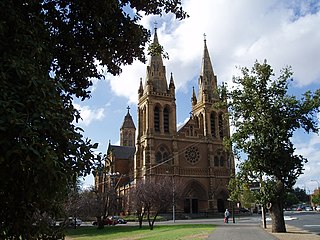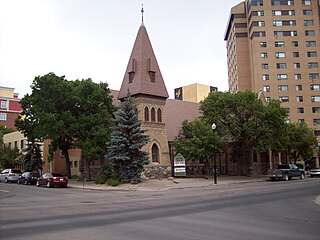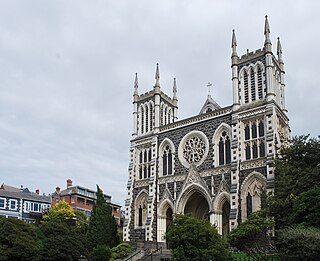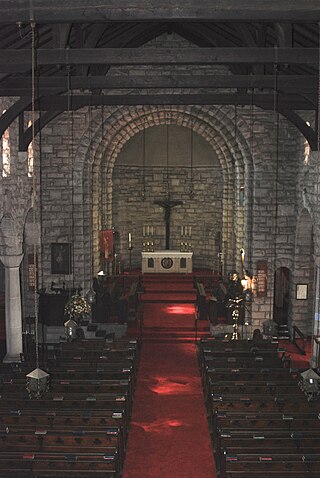
St Paul's Cathedral is an Anglican cathedral in Melbourne, Australia. It is the cathedral church of the Diocese of Melbourne and the seat of the Archbishop of Melbourne, who is also the metropolitan archbishop of the Province of Victoria.

The Wellington Cathedral of St Paul, also called St Paul's Cathedral or Wellington Cathedral, is an Anglican cathedral church located on Hill Street, at its junction with Molesworth Street, in Thorndon, in the city of Wellington, New Zealand. It is situated close to the parliament precinct.

St Andrew's Cathedral is a cathedral church of the Anglican Diocese of Sydney in the Anglican Church of Australia. The cathedral is the seat of the Anglican Archbishop of Sydney and Metropolitan of New South Wales. The position of Dean of Sydney has been held by the Very Reverend Sandy Grant since 9 December 2021.
The Anglican Church in Aotearoa, New Zealand and Polynesia, formerly the Church of the Province of New Zealand, is a province of the Anglican Communion serving New Zealand, Fiji, Tonga, Samoa, and the Cook Islands. Since 1992 the church has consisted of three tikanga or cultural streams: Aotearoa, New Zealand, and Polynesia. The church's constitution says that, among other things, it is required to "maintain the right of every person to choose any particular cultural expression of the faith". As a result, the church's General Synod has agreed upon the development of the three-person primacy based on this three tikanga system; it has three primates, each representing a tikanga, who share authority.

St Peter's Cathedral is an Anglican cathedral in the South Australian capital of Adelaide. It is the seat of the Archbishop of Adelaide and Metropolitan of the Province of South Australia. The cathedral, a significant Adelaide landmark, is situated on approximately 1 acre (0.40 ha) of land at the corner of Pennington Terrace and King William Road in the suburb of North Adelaide.
Penelope Ann Bansall Jamieson is a retired Anglican bishop. She was the seventh Bishop of Dunedin in the Anglican Church of New Zealand from 1989 until her retirement in 2004. Jamieson was the second woman in the world, after Barbara Harris, to hold the position of bishop in the Anglican Communion and the first to be elected a diocesan bishop.

Holy Trinity Cathedral is an Anglican cathedral situated in Parnell, a residential suburb of Auckland, New Zealand. It is the 'mother church' of the Anglican Diocese of Auckland and the seat of the Bishop of Auckland. The current main church building was consecrated in 1973.

St Paul's Anglican Cathedral is an historic church building located on the outskirts of Regina's central business district. Built as a parish church in 1894–1895, it became the pro-cathedral of the Anglican Diocese of Qu'Appelle in southern Saskatchewan, Canada, in 1944 when pro-cathedral status was removed from St Peter's, Qu'Appelle, in the eponymous former see city which had become moribund. In 1973, when it had become clear that the once-planned grand cathedral for Regina — at the corner of Broad Street and College Avenue — was no longer a feasible project, its status was raised to that of cathedral.

The Diocese of Dunedin is one of the thirteen dioceses and hui amorangi of the Anglican Church in Aotearoa, New Zealand and Polynesia.

St Joseph's Cathedral is the cathedral for the Roman Catholic Diocese of Dunedin. It is located in City Rise in the city of Dunedin, New Zealand. It serves as the seat of the bishop of the Latin Church Diocese of Dunedin, which was erected on 26 November 1869.
Samuel Tarratt Nevill, was the first Anglican Bishop of Dunedin, before becoming Primate of New Zealand.

The Cathedral of St. Mary the Virgin or St. Mary's Cathedral is the cathedral of the Diocese of West Malaysia of the Anglican Church of the Province of South East Asia, located in Kuala Lumpur, Malaysia. It is the episcopal see of the Anglican Bishop of West Malaysia and the mother church of the diocese.
The Diocese of Mthatha is a diocese of the Anglican Church of Southern Africa in the Eastern Cape province of South Africa. Before 2006 it was known as the Diocese of St John's, and earlier still as that of Kaffraria. The diocese currently has 96 parishes.

St Boniface Church is the mother church of the Anglican parish of Germiston, Gauteng which also includes the chapelries of St Mary and St John in Lambton, and St Mark in Rosedeep. The parish is part of the Diocese of the Highveld, which is in turn part of the Anglican Church of Southern Africa.

All Saints' Church is a heritage-listed Anglican church located in Dunedin, New Zealand. Established in 1865, the church is part of the Dunedin North parish in the Diocese of Dunedin.

Christ Church Cathedral is a heritage-listed Anglican cathedral complex at Duke Street, Grafton, Clarence Valley Council, New South Wales, Australia. The cathedral was designed by John Horbury Hunt and built from 1874 to 1884 by Reynold Brothers (brickwork) and G. J. T. Lawson (woodwork). It is also known as Cathedral Church of Christ the King and Grafton Anglican Cathedral. The property is owned by the Anglican Diocese of Grafton. It was added to the New South Wales State Heritage Register on 14 March 2003.

St Paul's Anglican Cathedral is an Australian heritage-listed cathedral at 89 William Street, Rockhampton, Rockhampton Region, Queensland. It was designed principally by Annersley Voysey and built from 1883 to 1953. It is also known as St Paul's Church of England and St Paul's Church of England Cathedral. It was added to the Queensland Heritage Register on 21 October 1992. The associated hall and offices were listed on the Queensland Heritage Register on 23 June 2000.

Trinity Episcopal Cathedral is an Episcopal cathedral located in Trenton, New Jersey, United States. It is the seat of the Diocese of New Jersey.

St John's Cathedral, Napier, officially the Waiapu Cathedral of Saint John the Evangelist, is an Anglican cathedral church, located in Browning Street, Napier, New Zealand.

Cathedral of St Mark in George, South Africa is the seat of the Diocese of George of the Anglican Church of Southern Africa. The present bishop is Edwin Desmond Pockpass.
























